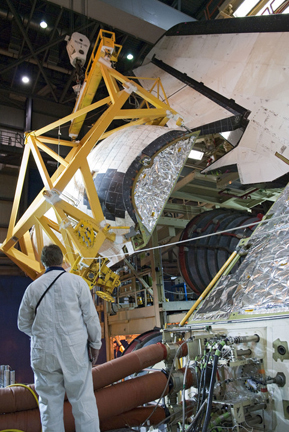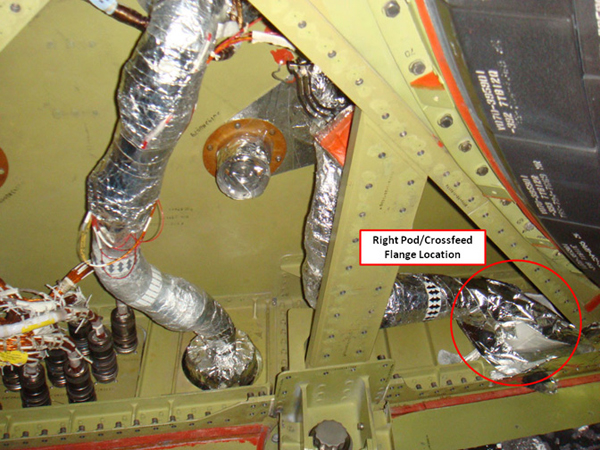Engineers troubleshoot propellant leak aboard shuttle Discovery (UPDATED)
Editor's note...
By WILLIAM HARWOOD
CBS News
KENNEDY SPACE CENTER, Fla.--Uncomfortable with an on-again, off-again leak in the plumbing used by the shuttle Discovery's maneuvering rockets, NASA managers Tuesday ordered engineers to forego additional testing and to press ahead instead with work to replace internal seals in a fuel line fitting.
Because the propellants are toxic, engineers will have to close launch pad 39A for normal work before draining the shuttle's orbital maneuvering system tanks and lines. After replacing seals in the fuel line flange where a small leak was observed over the weekend, the tanks will be refilled and additional tests will be carried out to make sure the fitting is tight and able to withstand the vibrations and pressures of launch.
Discovery's liftoff on a space station resupply mission is targeted for Nov. 1. The repair work is expected to take seven days to complete, but with four days of contingency time left in the shuttle's processing schedule, NASA managers believe the seals can be replaced in parallel with other work without impacting launch. If more invasive repairs are required, launch almost certainly would be delayed.
The trouble involves seepage of monomethyl hydrazine, or MMH, fuel at a crossfeed flange in the propellant plumbing of the shuttle's right-side orbital maneuvering system rocket pod. The shuttle is equipped with two such rocket pods, one on either side of the ship's vertical tail fin, that burn monomethyl hydrazine with an oxidizer, nitrogen tetroxide, to carry out maneuvers in orbit. Crossfeed lines in the shuttle's aft engine compartment allow propellants to be moved from one pod to the other.
Engineers suspected a leak last week. After testing over the weekend, they were able to trace the leak to a specific area of a flange in the crossfeed system where two sections of propellant line come together. But it is not yet clear whether the seepage was the result of trouble with seals in the flange or the flange itself.
The right-side OMS pod was removed after Discovery's most recent flight in April to repair a helium isolation valve in another part of the system. After the pod was re-installed in July, leak checks were normal and no obvious loss of pressure has been noted. But insulation around the flange was found to be damp with MMH over the weekend.
Overnight Monday, engineers checked the tightness of the six bolts holding the flange together and none of the bolts moved, indicating they were properly torqued. At the same time, the temperature of the system was changed, resulting in increased pressure in the fuel line. Subsequent measurements found no more traces of leakage.
"That's not the scenario they anticipated," a NASA official said.
The flange features two internal seals and it is possible the increased pressure helped seat one or both. Engineers developed a plan to pump helium into a test port Tuesday to pressurize the volume between the primary and secondary seals to look for any signs of additional leakage. Troubleshooters also considered pressurizing the line to flight levels of around 250 pounds per square inch to make sure the seals are properly seated and secure.
But given the toxic nature of MMH and the lack of a clear explanation for what started and stopped the leak, shuttle integration manager Mike Moses decided late Tuesday to replace the seals to make sure the problem is resolved. The replacement work was expected to get underway Wednesday.
Discovery is scheduled for launch on a space station resupply mission at 4:40 p.m. EDT (20:40 GMT) on Nov. 1. The launch window originally was expected to close on Nov. 5, but it later was extended to Nov. 6 and more recently, Nov. 7. If Discovery is not off the ground by then, the flight will be delayed at least to early December because of conflicts with other launches, already planned space station spacewalks and temperature restrictions due to the station's orbit.
Senior NASA managers plan to attend an executive-level flight readiness review at the Kennedy Space Center next Monday to review ground processing and to set an official launch date. Updates will be posted here as warranted.
- Updated at 01:40 p.m. EDT, 10/18/10: Correcting date of executive-level flight readiness review.
- Updated at 04:15 p.m. EDT, 10/18/10: Additional torque check/leak test ordered before seal replacement
- Updated at 11:30 a.m. EDT, 10/19/10: Torque checks on flange bolts show no problems; leak no longer present; troubleshooting continues
- Updated at 05:10 p.m. EDT, 10/19/10: NASA managers order seal replacement
 |
| The shuttle Discovery's right-side orbital maneuvering system rocket pod during post-servicing installation in July. (Photo: NASA) |
CBS News
KENNEDY SPACE CENTER, Fla.--Uncomfortable with an on-again, off-again leak in the plumbing used by the shuttle Discovery's maneuvering rockets, NASA managers Tuesday ordered engineers to forego additional testing and to press ahead instead with work to replace internal seals in a fuel line fitting.
Because the propellants are toxic, engineers will have to close launch pad 39A for normal work before draining the shuttle's orbital maneuvering system tanks and lines. After replacing seals in the fuel line flange where a small leak was observed over the weekend, the tanks will be refilled and additional tests will be carried out to make sure the fitting is tight and able to withstand the vibrations and pressures of launch.
Discovery's liftoff on a space station resupply mission is targeted for Nov. 1. The repair work is expected to take seven days to complete, but with four days of contingency time left in the shuttle's processing schedule, NASA managers believe the seals can be replaced in parallel with other work without impacting launch. If more invasive repairs are required, launch almost certainly would be delayed.
The trouble involves seepage of monomethyl hydrazine, or MMH, fuel at a crossfeed flange in the propellant plumbing of the shuttle's right-side orbital maneuvering system rocket pod. The shuttle is equipped with two such rocket pods, one on either side of the ship's vertical tail fin, that burn monomethyl hydrazine with an oxidizer, nitrogen tetroxide, to carry out maneuvers in orbit. Crossfeed lines in the shuttle's aft engine compartment allow propellants to be moved from one pod to the other.
Engineers suspected a leak last week. After testing over the weekend, they were able to trace the leak to a specific area of a flange in the crossfeed system where two sections of propellant line come together. But it is not yet clear whether the seepage was the result of trouble with seals in the flange or the flange itself.
The right-side OMS pod was removed after Discovery's most recent flight in April to repair a helium isolation valve in another part of the system. After the pod was re-installed in July, leak checks were normal and no obvious loss of pressure has been noted. But insulation around the flange was found to be damp with MMH over the weekend.
Overnight Monday, engineers checked the tightness of the six bolts holding the flange together and none of the bolts moved, indicating they were properly torqued. At the same time, the temperature of the system was changed, resulting in increased pressure in the fuel line. Subsequent measurements found no more traces of leakage.
"That's not the scenario they anticipated," a NASA official said.
 |
| NASA managers decided Tuesday to replace internal seals in a fuel line flange aboard the shuttle Discovery to eliminate a small leak. (Photo: NASA) |
The flange features two internal seals and it is possible the increased pressure helped seat one or both. Engineers developed a plan to pump helium into a test port Tuesday to pressurize the volume between the primary and secondary seals to look for any signs of additional leakage. Troubleshooters also considered pressurizing the line to flight levels of around 250 pounds per square inch to make sure the seals are properly seated and secure.
But given the toxic nature of MMH and the lack of a clear explanation for what started and stopped the leak, shuttle integration manager Mike Moses decided late Tuesday to replace the seals to make sure the problem is resolved. The replacement work was expected to get underway Wednesday.
Discovery is scheduled for launch on a space station resupply mission at 4:40 p.m. EDT (20:40 GMT) on Nov. 1. The launch window originally was expected to close on Nov. 5, but it later was extended to Nov. 6 and more recently, Nov. 7. If Discovery is not off the ground by then, the flight will be delayed at least to early December because of conflicts with other launches, already planned space station spacewalks and temperature restrictions due to the station's orbit.
Senior NASA managers plan to attend an executive-level flight readiness review at the Kennedy Space Center next Monday to review ground processing and to set an official launch date. Updates will be posted here as warranted.